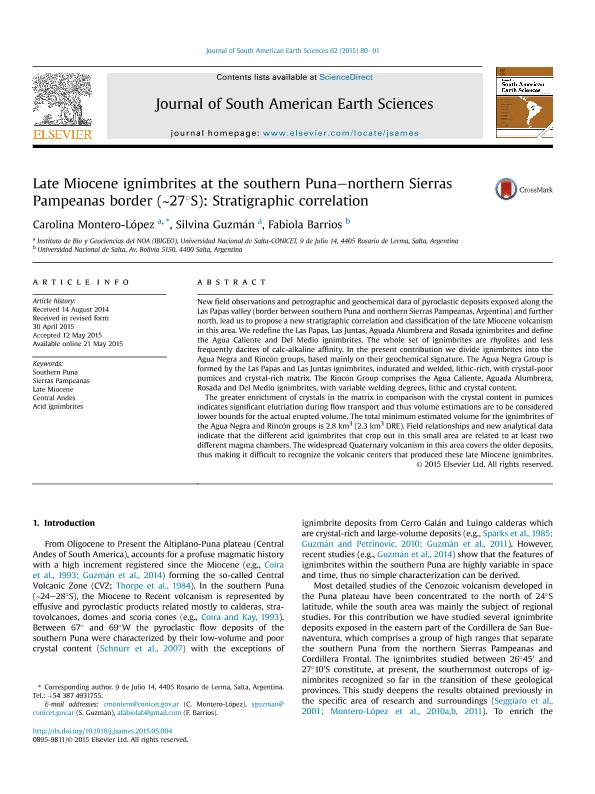Mostrar el registro sencillo del ítem
dc.contributor.author
Montero Lopez, Maria Carolina

dc.contributor.author
Guzman, Silvina Raquel

dc.contributor.author
Barrios, Fabiola
dc.date.available
2017-02-06T21:51:37Z
dc.date.issued
2015-10
dc.identifier.citation
Montero Lopez, Maria Carolina; Guzman, Silvina Raquel; Barrios, Fabiola; Late Miocene ignimbrites at the southern Puna-northern Sierras Pampeanas border (~27°S): Stratigraphic correlation; Elsevier; Journal Of South American Earth Sciences; 62; 10-2015; 80-91
dc.identifier.issn
0895-9811
dc.identifier.uri
http://hdl.handle.net/11336/12595
dc.description.abstract
New field observations and petrographic and geochemical data of pyroclastic deposits exposed along the Las Papas valley (border between southern Puna and northern Sierras Pampeanas, Argentina) and further north, lead us to propose a new stratigraphic correlation and classification of the late Miocene volcanism in this area. We redefine the Las Papas, Las Juntas, Aguada Alumbrera and Rosada ignimbrites and define the Agua Caliente and Del Medio ignimbrites. The whole set of ignimbrites are rhyolites and less frequently dacites of calc-alkaline affinity. In the present contribution we divide ignimbrites into the Agua Negra and Rincón groups, based mainly on their geochemical signature. The Agua Negra Group is formed by the Las Papas and Las Juntas ignimbrites, indurated and welded, lithic-rich, with crystal-poor pumices and crystal-rich matrix. The Rincón Group comprises the Agua Caliente, Aguada Alumbrera, Rosada and Del Medio ignimbrites, with variable welding degrees, lithic and crystal content.
The greater enrichment of crystals in the matrix in comparison with the crystal content in pumices indicates significant elutriation during flow transport and thus volume estimations are to be considered lower bounds for the actual erupted volume. The total minimum estimated volume for the ignimbrites of the Agua Negra and Rincón groups is 2.8 km3 (2.3 km3 DRE). Field relationships and new analytical data indicate that the different acid ignimbrites that crop out in this small area are related to at least two different magma chambers. The widespread Quaternary volcanism in this area covers the older deposits, thus making it difficult to recognize the volcanic centers that produced these late Miocene ignimbrites.
dc.format
application/pdf
dc.language.iso
eng
dc.publisher
Elsevier

dc.rights
info:eu-repo/semantics/openAccess
dc.rights.uri
https://creativecommons.org/licenses/by-nc-nd/2.5/ar/
dc.subject
Southern Puna
dc.subject
Sierras Pampeanas
dc.subject
Late Miocene
dc.subject
Central Andes
dc.subject
Acid Ignimbrites
dc.subject.classification
Vulcanología

dc.subject.classification
Ciencias de la Tierra y relacionadas con el Medio Ambiente

dc.subject.classification
CIENCIAS NATURALES Y EXACTAS

dc.title
Late Miocene ignimbrites at the southern Puna-northern Sierras Pampeanas border (~27°S): Stratigraphic correlation
dc.type
info:eu-repo/semantics/article
dc.type
info:ar-repo/semantics/artículo
dc.type
info:eu-repo/semantics/publishedVersion
dc.date.updated
2017-01-31T18:21:43Z
dc.journal.volume
62
dc.journal.pagination
80-91
dc.journal.pais
Países Bajos

dc.journal.ciudad
Amsterdam
dc.description.fil
Fil: Montero Lopez, Maria Carolina. Consejo Nacional de Investigaciones Científicas y Técnicas. Centro Científico Tecnológico Salta. Instituto de Bio y Geociencias del Noroeste Argentino; Argentina
dc.description.fil
Fil: Guzman, Silvina Raquel. Consejo Nacional de Investigaciones Científicas y Técnicas. Centro Científico Tecnológico Salta. Instituto de Bio y Geociencias del Noroeste Argentino; Argentina
dc.description.fil
Fil: Barrios, Fabiola. Universidad Nacional de Salta; Argentina
dc.journal.title
Journal Of South American Earth Sciences

dc.relation.alternativeid
info:eu-repo/semantics/altIdentifier/doi/http://dx.doi.org/10.1016/j.jsames.2015.05.004
dc.relation.alternativeid
info:eu-repo/semantics/altIdentifier/url/http://www.sciencedirect.com/science/article/pii/S0895981115000814
Archivos asociados
